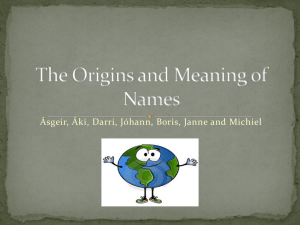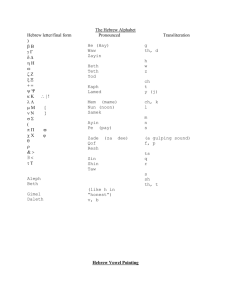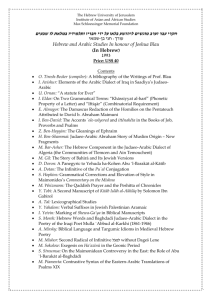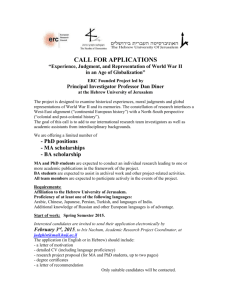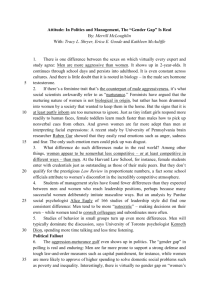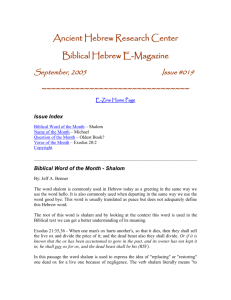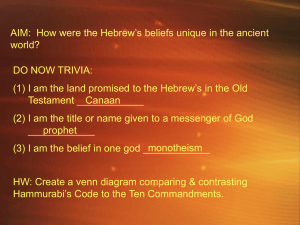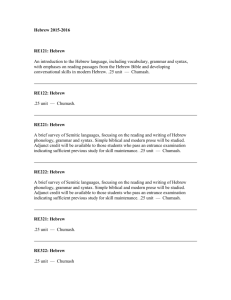Unit F192 - Translation, comprehension, composition and
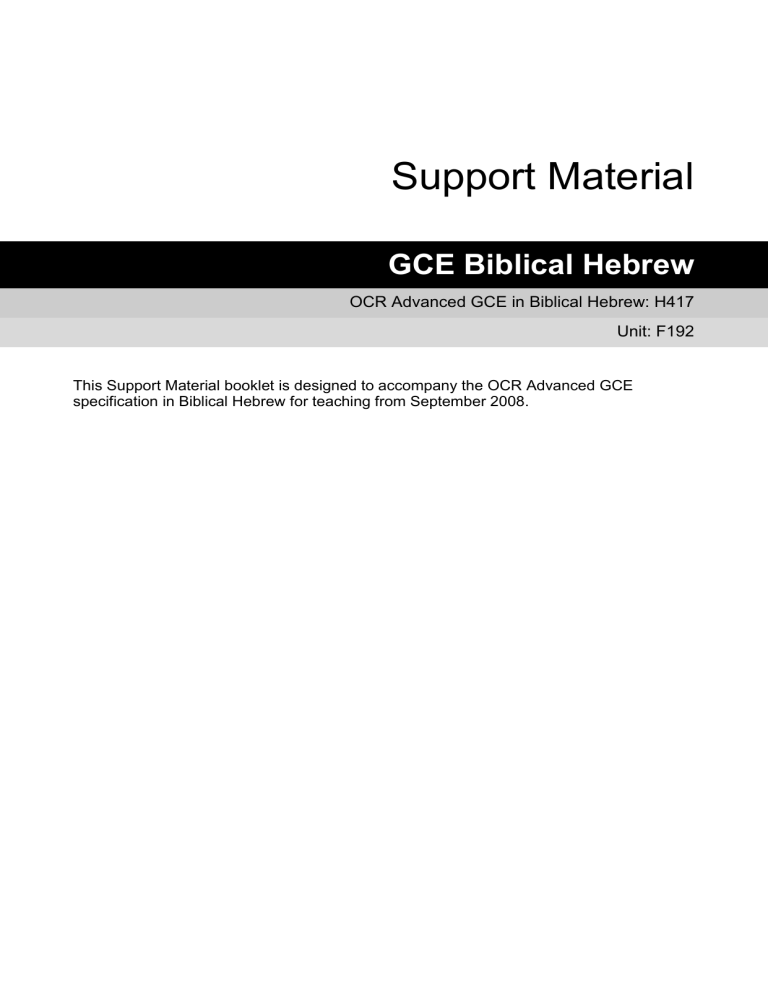
Support Material
GCE Biblical Hebrew
OCR Advanced GCE in Biblical Hebrew: H417
Unit: F192
This Support Material booklet is designed to accompany the OCR Advanced GCE specification in Biblical Hebrew for teaching from September 2008.
Contents
Translation, Comprehension, Composition and Literature: F192 (Section A)
Translation, Comprehension, Composition and Literature: F192 (Section B)
Sample Lesson Plan: Biblical Hebrew H417
Translation, Comprehension, Composition and Literature: F192
2 of 21 GCE Biblical Hebrew
Introduction
Background
A new structure of assessment for A Level has been introduced, for first teaching from September
2008. Some of the changes include:
The introduction of stretch and challenge (including the new A* grade at A2)
– to ensure that every young person has the opportunity to reach their full potential
The reduction or removal of coursework components for many qualifications – to lessen the volume of marking for teachers
A reduction in the number of units for many qualifications – to lessen the amount of assessment for learners
Amendments to the content of specifications – to ensure that content is up-to-date and relevant.
OCR has produced an overview document, which summarises the changes to Biblical Hebrew.
This can be found at www.ocr.org.uk
, along with the new specification.
In order to help you plan effectively for the implementation of the new specification we have produced this Scheme of Work and Sample Lesson Plans for Biblical Hebrew. These Support
Materials are designed for guidance only and play a secondary role to the Specification.
Our Ethos
All our Support Materials were produced ‘by teachers for teachers’ in order to capture real life current teaching practices and they are based around OCR ’s revised specifications. The aim is for the support materials to inspire teachers and facilitate different ideas and teaching practices.
Each Scheme of Work and set of sample Lesson Plans is provided in:
PDF format – for immediate use
Word format – so that you can use it as a foundation to build upon and amend the content to suit your teaching style and students’ needs.
The Scheme of Work and sample Lesson plans provide examples of how to teach this unit and the teaching hours are suggestions only. Some or all of it may be applicable to your teaching.
The Specification is the document on which assessment is based and specifies what content and skills need to be covered in delivering the course. At all times, therefore, this Support Material
GCE Biblical Hebrew 3 of 21
booklet should be read in conjunction with the Specification. If clarification on a particular point is sought then that clarification should be found in the Specification itself.
A Guided Tour through the Scheme of Work
= Innovative Teaching Idea
All the teaching ideas contained in the SOW are innovative, but the icon is used to
Highlight exceptionally innovative ideas.
= Stretch & Challenge Activity
This icon is added at the end of text when there is an explicit opportunity to offer
Stretch and Challenge.
= ICT Opportunity
This icon is used to illustrate when an activity could be taught using ICT facilities.
4 of 21 GCE Biblical Hebrew
Biblical Hebrew: H417
Translation, Comprehension, Composition and Literature: F192 (Section A)
Suggested teaching time
45 hours Topic Unprepared Translation and Comprehension
Topic outline
Unprepared Translation
Suggested teaching and homework activities
Select approximately 10 texts from both
Biblical prose and poetry. They could either be class readers or prepared at home for class use.
Questions naturally arise out of the text. Both past papers and the Model paper can be simulated.
Class could either act out various scenes or simulate prophetic reading using the original texts and supplemented with explanations in
English.
Suggested resources
This list is by no means prescriptive - merely to indicate the level of expectation.
Deuteronomy/Devarim 33 (1-9).
II Samuel/Shmuel 24.
Selections from Jeremiah/Yirmiyahu
4-7.
Ezekiel/Yehezkel 37, 47.
Zechariah 1.
Haggai 1.
I Chronicles 17-22.
Points to note
Students should use Hebrew and English
Lexicon, Oxford Press.
Personal vocabularies should be expanded from those prepared at AS
Level.
All past A2 unseen passages.
Use computer generated texts throughout (as with set texts).
= Innovative teaching idea
GCE Biblical Hebrew
= Stretch and challenge opportunity idea
= ICT opportunity
5 of 21
Biblical Hebrew: H417
Translation, Comprehension, Composition and Literature: F192 (Section A)
Suggested teaching time
5 hours Topic Unpointed Texts
Topic outline
Unpointed Texts
Suggested teaching and homework activities
2-3 lines of the unprepared translation should be left unpointed (Davka has this facility).
Suggested resources
As per Unprepared Translation and
Comprehensions.
Points to note
Should follow naturally from the unprepared translations.
Use this as an opportunity to reinforce the knowledge of accidence required at AS and
A2.
Davka: Biblical Hebrew text programme.
This exercise is only 3% of the examination and should only require infrequent practice.
6 of 21
= Innovative teaching idea = Stretch and challenge opportunity idea
= ICT opportunity
GCE Biblical Hebrew
Biblical Hebrew: H417
Translation, Comprehension, Composition and Literature: F192 (Section A)
Suggested teaching time
15 hours Topic Translation of English prose into Biblical Hebrew
Topic outline
Translation into Biblical
Hebrew
Suggested teaching and homework activities
Devise approximately 12-15 texts drawn from either Biblical or akin literature.
Use a modern English translation (adapt where necessary).
Initially aim at sentences only and gradually build up to small paragraphs (80 words).
Suggested resources Points to note
Any prose passage from the Bible or parallel literature (the so-termed Apocrayphal work).
Tobit.
Maccabees.
Judith are good sources. (Oxford &
Cambridge University Press have a readable version).
All the suggested books in the book list have appropriate exercises.
This is to put into active practice a demonstration of the candidates' ability to apply the accidence and syntax listed on the syllabus.
This is the reverse of translating from Biblical
Hebrew, but essentially draws on those skills.
= Innovative teaching idea
GCE Biblical Hebrew
= Stretch and challenge opportunity idea
= ICT opportunity
7 of 21
Biblical Hebrew: H417
Translation, Comprehension, Composition and Literature: F192 (Section A)
Suggested teaching time
5 hours Topic Unpointed Texts
Topic outline
Unpointed Texts
Suggested teaching and homework activities
2-3 lines of the unprepared translation should be left unpointed (Davka has this facility).
Suggested resources
As per Unprepared Translation and
Comprehensions.
Points to note
Should follow naturally from the unprepared translations.
Use this as an opportunity to reinforce the knowledge of accidence required at AS and
A2.
Davka: Biblical Hebrew text programme.
This exercise is only 3% of the examination and should only require infrequent practice.
8 of 21
= Innovative teaching idea = Stretch and challenge opportunity idea
= ICT opportunity
GCE Biblical Hebrew
Biblical Hebrew: H417
Translation, Comprehension, Composition and Literature: F192 (Section B)
Suggested teaching time
5 hours Topic Structure and Theme Judges / Shoftim 4
Topic outline
Judges / Shoftim 4
Suggested teaching and homework activities
Examine the position of the northern tribes
(note that the tribes were working in isolation).
Suggested resources
See map-work. The Living Nach Volume 1
(pp 108-109).
Oxford Bible Atlas (p61).
Points to note
The position of the Kenite clan (4:11). Can cross reference to Jeremiah / Yirmiyahu 35 (if selected for AS text).
See 1 Chronicle 2:55 for background note.
Consider the path of Sisera (4:14-16).
Consider the action of Yael (4: 17-23).
Computer generated texts.
Vocabulary listings.
Examine the role of women in this chapter.
Note all the unusual actions. Empathise with the female role. Use expressions from the original text in context. One can cross reference to Judges 5.
Hebrew English Lexicon - Oxford Press.
= Innovative teaching idea
GCE Biblical Hebrew
= Stretch and challenge opportunity idea
= ICT opportunity
9 of 21
Biblical Hebrew: H417
Translation, Comprehension, Composition and Literature: F192 (Section B)
Structure and Theme Judges / Shoftim 5 Suggested teaching time
5 hours Topic
Topic outline
The poetry of Judges / Shoftim
5
Suggested teaching and homework activities
Examine the text in translation prior to examining the Hebrew text. Note the main points.
Suggested resources
Anchor Bible Series: Judges.
* Book of Judges: Mosad HaRav Kook.
Points to note
Consider the structure of Hebrew poetry
(parallelism). Teacher resource: Gesenius p.14-15.
List the references to past history.
List at least five parallel phrases.
Note all the words used exclusively in a poetic setting. The class could be divided into groups - each group could express 3-4 verses in the original Hebrew in an expressive manner, explaining each phrase.
Computerised text - leaving large gaps for students' additions.
For fuller treatment see Sefer Shoftim: J.
Elizur (Mosad HaRav Kook) pp 56-60.
Hebrew and English Lexicon Oxford Press, and resources listed Judges 4.
Note the difficulty with 5:8: seemingly a shafal form with the archaic 2 nd feminine singular.
10 of 21
= Innovative teaching idea = Stretch and challenge opportunity idea
= ICT opportunity
GCE Biblical Hebrew
Biblical Hebrew: H417
Translation, Comprehension, Composition and Literature: F192 (Section B)
Suggested teaching time
5 hours Topic Structure and Theme Judges / Shoftim 6
Topic outline
Judges 6
Suggested teaching and homework activities
Examine the position of the western area of
Menashe and the threat of Midian and allied tribes (61; 6).
Suggested resources
As per Judges 4.
Points to note
Consider the position of Gideon who is taken from obscurity to save his sector (6: 7-16).
Times Atlas of the Bible, especially p.68-9.
Examine the theophanic nature of Gideon in his interface with the angel of G-d
(6: 19-24) (6: 36-40).
Define 'Baal' as an agricultural deity. See
The Time Atlas of the Bible, especially p.
102-3.
Consider the destruction of agricultural imagery (6: 25-32). Note that 6:35 reflects the same area of influence as Judges 4 (6:35).
Discuss the intended humour in 6: 31-32.
= Innovative teaching idea
GCE Biblical Hebrew
= Stretch and challenge opportunity idea
= ICT opportunity
11 of 21
Biblical Hebrew: H417
Translation, Comprehension, Composition and Literature: F192 (Section B)
Suggested teaching time
5 hours Topic Structure and Theme Judges / Shoftim 7
Topic outline
Judges 7
Suggested teaching and homework activities
Consider the story of Gideon's selection for his army.
Suggested resources
As per Judges 4-6.
*Note the use of dreams as indications / portents for the future (7: 13-15).
Trial Specification question.
Points to note
Note the use of Gideon's secondary name
(almost a 'nickname').
Note the use of the number 300 (7:7) concept of 'might' often contained in multiples of 30.
Consider why only small section of the tribes were involved. Note response and draw possible conclusion.
Book of Judges, Mosad HaRav Kook: maps p. 123-4.
12 of 21
= Innovative teaching idea = Stretch and challenge opportunity idea
= ICT opportunity
GCE Biblical Hebrew
Biblical Hebrew: H417
Translation, Comprehension, Composition and Literature: F192 (Section B)
Suggested teaching time
5 hours Topic Structure and Theme Judges / Shoftim 8
Topic outline
Judges 8
Suggested teaching and homework activities
Consider the jealousy of those tribes not selected (or involved) by Gideon and Gideon's diplomacy (8: 1-3).
Suggested resources
As per Judges 4-7.
Points to note
Consider the idiom in 8:16.
Consider Gideon's attitude towards the population on the east of the Jordan 8: 4-17.
See notes: The Living Nach Volume 1 p.
124-9.
Consider Gideon's refusal to be a permanent ruler and the aftermath of his leadership,
8: 18-34.
Select the idioms used in this passage and suggest reasons of how they originated.
= Innovative teaching idea
GCE Biblical Hebrew
= Stretch and challenge opportunity idea
= ICT opportunity
13 of 21
Biblical Hebrew: H417
Translation, Comprehension, Composition and Literature: F192 (Section B)
Suggested teaching time
5 hours Topic Structure and Theme Judges / Shoftim 9
Topic outline
Judges 9
Suggested teaching and homework activities
Consider the abuse of power inflicted by
Abimelech 9: 1-6.
Suggested resources
As per Judges 4-8.
Points to note
Consider the parable of Yotam and what it would have meant to the audience 9: 7-21. Encourage the different responses.
Consider the internal political manoeuvres against Abimelech and the destruction caused in order to maintain his position 9: 22-52.
Consider the role of the woman at the Tower of Tevez 9:53.
The Living Nach, Volume 1 (especially map p.134).
Essay: Consider the role of women in
Judges / Shoftim 4-9. What do you consider the unusual aspects of this behaviour?
Note the part played by women in this section of Judges.
14 of 21
= Innovative teaching idea = Stretch and challenge opportunity idea
= ICT opportunity
GCE Biblical Hebrew
Biblical Hebrew: H417
Translation, Comprehension, Composition and Literature: F192 (Section B)
Suggested teaching time
30 hours Topic The Structure and Themes of Isaiah / Yishaya 59-66
Topic outline
Contents of Isaiah / Yeshaya
59-66
Suggested teaching and homework activities
Divide set chapters into topics. One possibility is that suggested in The Living Nach Volume 3 or a more general one suggested in the Book of Isaiah, Mosad HaRav Kook.
Log the themes that are positive (the vast majority of these prophetic writings).
Suggested resources
Volume 3: The Living Nach, The Later
Prophets Y. Elman.
Book of Isaiah: Mosad HaRav Kook Volume
2: A Hakham.
Points to note
See notes on Judges / Shoftim 5.
Full notes on the poetic structure are given in this edition.
Log the minority of themes that are negative:
59 (1-15);
65 (1-6);
65 (11);
66 (3-6).
Groups to consider how the prophet changes rapidly from the negative to the positive.
Should note how the language changes.
Used model question and solutions for the standard required.
Use computerised texts as outlined with other set texts.
= Innovative teaching idea
GCE Biblical Hebrew
= Stretch and challenge opportunity idea
= ICT opportunity
15 of 21
Biblical Hebrew: H417
Translation, Comprehension, Composition and Literature: F192 (Section B)
Suggested teaching time
24 hours Topic The Structure and Theme of Psalms / Tehillim 120 - 134
Topic outline
The structure, meaning and use of Psalms 120-134
Suggested teaching and homework activities
Initially read the texts in English to obtain an overall meaning.
Suggested resources
Sefer Tehillim: Mosad HaRav Kook, Volume
2, A Hakham.
Points to note
Note poetical language and the use of parallelism throughout.
Examine each Psalm for the varying themes.
Keep a log of both positive and negative voices recorded.
Computerised texts - allow for individual student notes.
See notes to Judges / Shoftim 5. To consider how poetry arouses the conscience.
Keep a log of parallel ideas across the various psalms. Keep a log of the words/phrases used in poetry and their individual sources.
The Living Nach, Volume 3.
Essay: Consider common superscription.
Consider the centrality of
Jerusalem to the poetic themes.
16 of 21
= Innovative teaching idea = Stretch and challenge opportunity idea
= ICT opportunity
GCE Biblical Hebrew
Biblical Hebrew: H417
Translation, Comprehension, Composition and Literature: F192 (Section B)
Suggested teaching time
6 hours Topic The Structure and Theme of Psalms / Tehillim 146-148
Topic outline
The structure, meaning and use of Psalms 146-148.
Suggested teaching and homework activities
As per Psalms / Tehillim 120-134.
Suggested resources
As per Psalms / Tehillim 120
– 134.
Points to note
Note the different superscription.
Show how these vary from Psalms / Tehillim
120 – 134.
Note the 'warning signs' of the Psalmist. Note the 'use of nature' by the Psalmist.
Consider the purpose of Psalm literature.
Divide into small groups - each offering three reasons with appropriate quotes.
= Innovative teaching idea
GCE Biblical Hebrew
= Stretch and challenge opportunity idea
= ICT opportunity
17 of 21
Sample Lesson Plan: Biblical Hebrew H417
Translation, Comprehension, Composition and Literature: F192
To overcome the fear of translating from English into Biblical Hebrew
OCR recognises that the teaching of this qualification will vary greatly from school to school and from teacher to teacher. With that in mind, this lesson plan is offered as a possible approach but will be subject to modifications by the individual teacher.
Lesson length is assumed to be one hour .
Learning objectives for the lesson
Objective 1
Objective 2
Objective 3
Students to understand that the skill is basic and that they are not expected to emulate the brilliance of the Biblical writers.
Students are to understand that if they are efficient at recognising Biblical
Hebrew accidence and have conscientiously read their set-texts and read some unprepared texts - then they will be on their way to success.
To prove the above to the students.
Content
Time
5 minutes
5 minutes
10 minutes
20 minutes
10 minutes
Content
Ask students to write down some basic Hebrew words e.g. boy, table, the boy, the table, they sat, they will sit.
Choose some well known Biblical quotations in English and ask the class to translate them into Hebrew (can divide into groups).
Put results on the white-board (or equivalent).
Set a basic exercise from one of the text books in the book list.
Compare results. Ask for class to improve each others' results.
Consolidation
Time
10 minutes
Content
Analyse any short Hebrew passage, two to three sentences and demonstrate how the Biblical author has used accidence and syntax. Use this as an example for future emulation.
18 of 21 GCE Biblical Hebrew
Sample Lesson Plan: Biblical Hebrew H417
Translation, Comprehension, Composition and Literature F192
An introduction to Psalm 129 and an analysis of verses 1-3
OCR recognises that the teaching of this qualification will vary greatly from school to school and from teacher to teacher. With that in mind, this lesson plan is offered as a possible approach but will be subject to modifications by the individual teacher.
Lesson length is assumed to be one hour .
Learning objectives for the lesson
Objective 1
Objective 2
Objective 3
To understand in broad terms the contents of Psalm 129.
To read carefully the first three verses and appreciate the Hebrew style.
To be able to translate and understand verses 1-3 in their context.
Content
Time
5 minutes
5 minutes
10 minutes
20 minutes
10 minutes
Content
Elicit from the class the meaning of 'Shir Hamaalot'. Allow for a number of opinions.
Distribute the psalm in English and Hebrew text (computerised) with appropriate vocabulary and analysis. Quick glance at the task.
Allow class to work in pairs and work out the main ideas - using both English and Hebrew text.
Analyse the first three verses with the class initially working on known vocabulary and then introducing new words/phrases.
Look at any difficulties with the poetical nuances checking against distributed analysis.
Consolidation
Time
10 minutes
Content
Allow the class to revise the first three verses checking that they understand the psalm fully. End with two or three oral questions to test this objective.
GCE Biblical Hebrew 19 of 17
Other forms of Support
In order to help you implement these new specification effectively, OCR offers a comprehensive package of support. This includes:
OCR Training
Get Ready…introducing the new specifications
A series of FREE half-day training events are being run during Autumn 2007, to give you an overview of the new specifications.
Get Started…towards successful delivery of the new specifications
These full-day events will run from Spring 2008 and will look at the new specifications in more depth, with emphasis on first delivery.
Visit www.ocr.org.uk
for more details.
Mill Wharf Training
Additional events are also available through our partner, Mill Wharf Training. It offers a range of courses on innovative teaching practice and whole-school issues - www.mill-wharf-training.co.uk
.
e-Communities
Over 70 e-Communities offer you a fast, dynamic communication channel to make contact with other subject specialists. Our online mailing list covers a wide range of subjects and enables you to share knowledge and views via email.
Visit https://community.ocr.org.uk
, choose your community and join the discussion!
Interchange
OCR Interchange has been developed to help you to carry out day to day administration functions online, quickly and easily. The site allows you to register and enter candidates online. In addition, you can gain immediate a free access to candidate information at you convenience. Sign up at https://interchange.ocr.org.uk
20 of 21 GCE Biblical Hebrew
Published Resources
Published Resources
OCR offers centres a wealth of quality published support with a fantastic choice of ‘Official
Publisher Partner’ and ‘Approved Publication’ resources, all endorsed by OCR for use with OCR specifications.
Publisher partners
OCR works in close collaboration with three Publisher Partners; Hodder, Heinemann and Oxford
University Press (OUP) to ensure centres have access to:
Better published support, available when you need it, tailored to OCR specifications
Quality resources produced in consultation with OCR subject teams, which are linked to
OCR’s teacher support materials
More resources for specifications with lower candidate entries
Materials that are subject to a thorough quality assurance process to achieve endorsement
Oxford University Press (OUP) is the publisher partner for OCR GCE Biblical Hebrew
Approved publications
OCR still endorses other publisher materials, which undergo a thorough quality assurance process to achieve endorsement. By offering a choice of endorsed materials, centres can be assured of quality support for all OCR qualifications.
Endorsement
OCR endorses a range of publisher materials to provide quality support for centres delivering its qualifications. You can be confident that materia ls branded with OCR’s “Official Publishing Partner” or “Approved publication” logos have undergone a thorough quality assurance process to achieve endorsement. All responsibility for the content of the publisher’s materials rests with the publisher.
These endorsements do not mean that the materials are the only suitable resources available or necessary to achieve an OCR qualification. Any resource lists which are produced by OCR shall include a range of appropriate texts
GCE Biblical Hebrew 21 of 17
